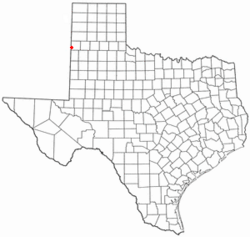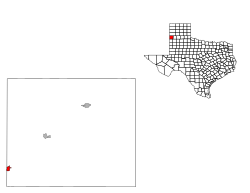Farwell, Texas facts for kids
Quick facts for kids
Farwell, Texas
|
|
|---|---|

Farwell City Hall
|
|

Location of Farwell, Texas
|
|
 |
|
| Country | United States |
| State | Texas |
| County | Parmer |
| Area | |
| • Total | 0.82 sq mi (2.13 km2) |
| • Land | 0.82 sq mi (2.13 km2) |
| • Water | 0.00 sq mi (0.00 km2) |
| Elevation | 4,144 ft (1,263 m) |
| Population
(2020)
|
|
| • Total | 1,425 |
| • Density | 1,738/sq mi (669.0/km2) |
| Time zone | UTC-6 (Central (CST)) |
| • Summer (DST) | UTC-5 (CDT) |
| ZIP code |
79325
|
| Area code(s) | 806 |
| FIPS code | 48-25548 |
| GNIS feature ID | 1357260 |
Farwell is a city in Texas, United States. It's the main town, or county seat, of Parmer County. In 2020, about 1,425 people lived there. Farwell sits right on the border between Texas and New Mexico. Right across the border is another town called Texico.
Contents
History of Farwell, Texas
Farwell started as a small camp for cowboys working on the XIT Ranch. This ranch was huge and began in 1880. The city was named after two brothers, Charles B. and John V. Farwell. They helped build the Texas State Capitol building. In return, they received a massive amount of ranchland, about 3,050,000 acres.
Early Days and Native Americans
Before the ranch, the Comanche people controlled this part of Texas. They had lived there since about 1725. The Red River War happened in 1874–1875. This was a big military operation where U.S. armies fought the Comanche. The Comanche were defeated in Palo Duro Canyon, about 80 miles northeast of Farwell. Their horses were driven off and killed, which weakened their forces.
The XIT Ranch and Settlers
The Farwell brothers started the XIT Ranch on their new land. They hired many cowboys and built over 6,000 miles of barbed wire fences. They even hired former Texas Rangers to stop cattle rustlers. Some people believe the ranch faced problems because of all the cattle theft. This led the owners to start selling parts of the ranch. Families were drawn to the area by the low prices of land.
Becoming the County Seat
The exact date Farwell started as a cow camp isn't known. But in 1907, Parmer County was created. An election was held to decide which town would be the county seat. Farwell competed against Bovina, Parmerton, and Friona. Parmerton was first chosen as the county seat, and a courthouse was built there.
However, other towns disagreed with the results. So, a new vote was planned. A new rule was made: cowboys, who often moved around, had to vote where they did their laundry. Farwell was the only town with a laundry service at that time. Because of this, Farwell received all the cowboy votes. In 1908, Farwell became the county seat. A courthouse was quickly built in Farwell.
Arrival of the Railroad
When the XIT Ranch began selling land, settlers arrived in Farwell by train. The railroad reached Farwell in 1899. It connected the eastern and western parts of the country. Families from all over America came by train. They stayed at the four-story Farwell Hotel. Then, they toured the available land in cars.
Many families traveled in covered wagons. They built their homes in "dugouts" in the prairie soil. This was because there were no stones or trees for building. Farming and raising animals were often risky due to droughts and wind. But families worked hard, often relying on windmills for water. This water helped them grow food and keep a few animals.
Geography of Farwell
Farwell is located on the flat plains of the Llano Estacado. It covers about 0.8 square miles, and all of it is land.
Location and Transportation
The city is about 10 miles east of Clovis, New Mexico. It's also 88 miles northwest of Lubbock, Texas, and 95 miles southwest of Amarillo, Texas. Farwell is an important spot for the BNSF Railway. Two train lines meet here. One goes northeast toward Amarillo, and the other goes southeast toward Lubbock and the Texas Gulf Coast.
The Texas-New Mexico Border Dispute
For many years, there has been a disagreement about whether Farwell belongs to Texas or New Mexico. The border between the two states was supposed to be a straight line, the 103rd meridian. However, a survey in 1859 mistakenly placed the border too far west. This made towns like Farwell appear to be in Texas.
The disputed area is hundreds of miles long. It includes parts of valuable oilfields in the Permian Basin. New Mexico once tried to sue Texas in the U.S. Supreme Court to get this land back. However, the plan did not become law. Today, the land in this strip is considered part of Texas. It is taxed and governed by the State of Texas.
Population of Farwell
Farwell has a population of 1,425 people, according to the 2020 census. The table below shows how the population has changed over the years.
| Historical population | |||
|---|---|---|---|
| Census | Pop. | %± | |
| 1960 | 1,009 | — | |
| 1970 | 1,185 | 17.4% | |
| 1980 | 1,354 | 14.3% | |
| 1990 | 1,373 | 1.4% | |
| 2000 | 1,364 | −0.7% | |
| 2010 | 1,363 | −0.1% | |
| 2020 | 1,425 | 4.5% | |
| U.S. Decennial Census | |||
Farwell's Diverse Community (2020 Census)
In 2020, there were 1,425 people living in Farwell. There were 541 households and 358 families. The community is made up of people from different backgrounds.
| Race | Number | Percentage |
|---|---|---|
| White (NH) | 748 | 52.49% |
| Black or African American (NH) | 9 | 0.63% |
| Native American or Alaska Native (NH) | 1 | 0.07% |
| Asian (NH) | 3 | 0.21% |
| Some Other Race (NH) | 2 | 0.14% |
| Mixed/Multi-Racial (NH) | 8 | 0.56% |
| Hispanic or Latino | 654 | 45.89% |
| Total | 1,425 |
Education in Farwell
Students in Farwell attend schools that are part of the Farwell Independent School District.
Notable People from Farwell
- Charlie Phillips, a singer and songwriter, is from Farwell.
Images for kids
See also
 In Spanish: Farwell (Texas) para niños
In Spanish: Farwell (Texas) para niños








